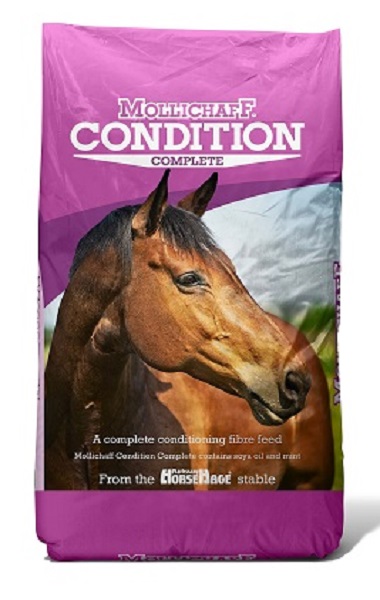Posted: 2nd November 2017 | Back to news feed

Feeding for Winter Condition
Feeding our horses to keep them in the best possible condition can cause a headache for many of us, especially over the colder months if we have a picky horse or one with a poor appetite. Dependant on age, breed and work load, horses will naturally tend to carry different proportions of fat and muscle and it is important we ensure our horse’s diet provides the appropriate calories (or energy) to maintain a healthy weight, whilst, alongside correct work, giving them the building blocks for muscle development.
Mollichaff Condition Complete is a highly digestible, high fibre, high oil and low starch blend in a single bag. It can be fed as a complete concentrate feed alongside good quality forage, when fed at the recommended levels, and contains a broad spectrum vitamin and mineral supplement. This makes life easier for you as you don’t need to shop for anything else to feed other than good quality forage, because it contains all the dietary requirements your horse or pony needs.

It is made from a balanced blend of alfalfa, dried grass, oat straw, fibre pellets, barley, soya flakes, soya oil and mint, plus Yea-sacc® - a natural live yeast culture - and a prebiotic to help maintain a healthy digestive system.
Essential fatty acids are provided by the soya oil to help maintain healthy skin and encourage a glossy coat.
Mollichaff Condition Complete is suitable for encouraging weight gain in underweight horses and ponies and can also help to maintain weight and condition in competition horses and ponies.
Because it is a fibre-based feed, it provides a more natural way of feeding your horse or pony compared to a high cereal diet. The addition of mint makes Mollichaff Condition Complete particularly appealing to horses because of its taste and aroma, so your horse should really enjoy it!
Here are some tips for feeding for condition:
- Never underestimate the importance of forage – always allow ad lib access to the best quality forage you can afford. Ideally it should also be dust-free.
- Don’t forget the fibre element of your bucket feed. Use high calorie fibre sources or a ‘complete’ feed to enable you to keep cereals (and therefore starch levels) to a minimum.
- Never try to rush weight gain. Slow and steady is by far the safest for your horse. Assessing your horse’s weight weekly using a weigh tape will allow you to notice any unusual changes.
- Try to keep an underweight horse as warm as possible; he will lose a significant amount of calories trying to generate heat.
- Look for ‘complete’ feeds that contain digestive enhancers such as yeast and prebiotics.
- Don’t confuse fat with muscle. You will not achieve a well-developed top line through feed alone, correct work is also essential.
For more information on feeding your horse or pony, please contact the HorseHage & Mollichaff Helpline on 01803 527274 or visit www.horsehage.co.uk
The Equestrian Index newsfeed is compiled from articles submitted by advertising members and expresses the opinions of those members. Watsons Directories Ltd shall not be held liable for any inaccuracies or mis-statements therein.